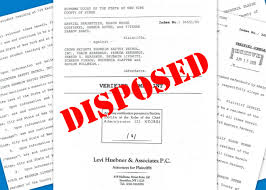
In this article, Shreyanshi Maheshwari a student of Symbiosis Law School, NOIDA discusses the procedure of filing a Legal Notice. She also provided for the drafting guide along with the sample legal notices in different matters.
Introduction
There are several occasions when a person or an entity needs to take a legal action against another person or an entity. The several occasions can be consumer complaint, property dispute, check bounce, divorce, eviction and many more. However, it is important for you to inform the other person that you are going to initiate a legal action against them. That is the reason, you send a legal notice to a person or an entity.
What is a Legal Notice?
A Legal notice is a formal written document sent by a person or an entity with respect to some grievance. It is sent as a warning to the receiver that the one sending the notice have certain grievances which are not properly taken care of by the receiver, although the receiver has given enough opportunity to the receiver to resolve the problem.
It is like a final warning to the receiver that the sender is all prepared to initiate a legal action and it is the final opportunity for the receiver to resolve the issue in hand properly.
Importance of filing a Legal Notice
Certain situations may arise where you get confused about how to initiate legal action in order to resolve your matter. The filing of a legal notice gives a new beginning to your journey of litigation. Therefore it has various aspects in which it is important:
- By sending legal notice it can give a clear intention on the part of the sender to file a lawsuit for the purpose of resolving the issue to which the other party might respond immediately to save oneself from court proceedings.
- A person can easily describe his grievance in a legal notice with the help of an Advocate.
- Serving of legal notice gives an opportunity to the receiver of the legal notice, that is, the opposite party to resolve the issue cordially.
- It acts as a reminder for the receiver of the legal notice about the acts that have intentionally or unintentionally have created a problem for the sender.
When to send a Legal Notice?
There are numerous reasons for which you can send a legal notice to a person or an entity. However, the most common ones are:
- Disputes related to property such as mortgage, delayed possession delivery by the builder, eviction of the tenant, the partition of family property, etc.
- Notice to the employer for wrongful termination, unpaid salary, violation of any right of the employee by the employer, etc.
- Notice to the employee for violation of the HR policies, sexual harassment act at the workplace, leaving the job without handing over the resignation letter, violation of any provision of the employment agreement, etc.
- Notice to a company manufacturing or providing service of faulty products, faulty services, false advertisement, etc.
- Notice in the case of cheque bounce to the issuer of the cheque.
- Notice in case of personal conflicts such as divorce, maintenance, child custody, etc.
Legal Notice under section 80 of The Code of Civil Procedure, 1908
A Legal Notice is generally filed in civil cases. In the criminal cases, there is no filing of the legal notice as in case of a criminal offense the action is instituted by the State against the person committing the offense as State is the supreme power. However, if you intend to initiate a civil suit against the Government you have to serve a legal notice to the Government beforehand and only thereafter you can file a civil suit against the Government.
Section 80 of The Code of Civil Procedure, 1908 provides for sending of a legal notice to the Government or public officer if one wants to initiate a legal action against them for any act claimed to be done by such public officer during the course of his official duty until the expiration of two months. The purpose of the notice is to give Secretary of State or the public officer a chance to reevaluate his legal position and to offer some kind of compensation without going to a court of law.
In Bihari Chowdhary v. State of Bihar [AIR 1984 SC 1043], Supreme Court has stated that “The object of the section is the advancement of justice and the securing of public good by avoidance of unnecessary litigation”.
For Section 80 of The Code of Civil Procedure, 1908 (see here).
Essentials of Section 80 of Code of Civil Procedure, 1908
- Name, description, and place of residence of the sender of the notice.
- Statement of cause of action.
- The relief claimed by the sender of the notice.
- Summary of the legal basis for the relief claimed.
Is serving of Legal Notice mandatory?
As per Section 80 of the Code of Civil Procedure, 1908 it is mandatory to serve a legal notice before the filing of a suit if the opposite party is Government or Public officer. But, in practicality, it is seen that Advocates serve legal notice before the filing of all the Civil cases. However, it is not mandatory to serve a legal notice in all civil cases except in case of the filing of a suit against Government or Public officer but formally it is been sent by the party intending to sue.
The reason behind this is to bring it to the knowledge of the opposite party that the sender of notice is making the last effort to settle the matter in hand. Also, it gives a credibility to the story of the sender as it expressly states all the liabilities of the receiver.
Legal Notice under Section 138 of The Negotiable Instrument Act, 1881
In the case of a cheque bounce, it is mandatory to send a legal notice to the issuer of cheque within a time frame of 30 days from the date of cheque bounce. If no repayment of money is received after 15 days of the delivery of the legal notice, then you can initiate a legal action within 30 days from the date of completion of 15 days time period.
Criminal liability is also established under this section wherein the drawer of the dishonored cheque may get a sentence of 2 years jail term or fine or both.
- In the notice, you have to provide details of the transaction for which the cheque was issued, details of the cheque, details of dishonor, etc. through a lawyer.
- Notice to be signed by both lawyer and payee.
- Notice to be sent through registered post.
For Section 138 of The Negotiable Instrument Act, 1881 (see here)
How to draft a Legal Notice?
A legal notice is essentially a notice sent by an advocate on the behalf of his/her client. It is not mandatory for a person to send a legal notice through an advocate, he/she can send a legal notice on his/her own accord without the assistance of an advocate.
It is not even mandatory to send a legal notice as there is no specific provision/enactments of law that make it mandatory to issue a legal notice before filing a suit.
A legal notice is generally issued by an advocate on behalf of his/her client for the purpose of soliciting a settlement. It is issued either to accept the settlement or to reject it altogether in order to avail a civil suit or legal remedies.
Demo Legal Notice
Step 1
Below is a sample letterhead of the advocate who is issuing the legal notice. The letterhead is to be specific and proper, it has to have addresses and contact details of the advocate. This aspect is very important as a letterhead needs to be specific and clear so that the opposite party may respond to the advocate in case they wish to contact the advocate. The date on which the legal notice is issued and the name, address and contact details of the person to whom the legal notice is issued is to be stated and accordingly, the notice is to be commenced.
A legal notice could be sent through a Registered A.D. or through a courier. There is no specific procedure to issue a legal notice. The notice can also be personally tendered to the opposite party, as long as the opposite party is willing to receive it and sign an acknowledgment of its receipt. There is no compulsion to send a legal notice only through a Registered A.D. or through a courier. The reason it is preferred to send it through Registered A.D. is that the receiver acknowledges the receipt of the notice on the Registered A.D. card which is then returned back to the sender, therefore, it becomes a document of proof as it regards the opposite party having received or receives the legal notice.
Now, getting into the notice the first paragraph should be “Under the instruction of my clients _______ residents of _______. I have to address you as under-”. This is the system that is generally followed, but you can also follow a different system.
For example- I am concerned for my client _______ who is a resident of _______ and accordingly, I have the privilege of addressing you upon his/her instructions.
Step 2
Every paragraph in the notice is to be prefixed with the phrase “My Clients state”. This is a very good practice as the opposite party has to know that the statements that are being stated in the notice are coming directly from the client and that they are not created or fabricated by the advocate. When this phrase is prefixed before every paragraph, the opposite party understands that the client is instructing the advocate specifically to state such statements in the notice and the opposite party understands that whatever the advocate is saying is based upon the client’s instruction so that the reputation of the advocate is not tarnished in front of the opposite party and helps in inviting the settlement.
The notice that is being provided here is a notice that is been issued by the landlord to the tenant for the purpose of recovery of rent, that is, the tenant has defaulted in making the payment of rent, therefore, the landlord is issuing a statutory notice to the tenant calling upon the tenant to make payment of the rent of a specific period defaulting which the landlord should be constrained to pursue civil remedies before the civil courts.
You can see the contents of the notice below and know that how to draft a legal notice and what language is to be used while drafting, but one thing that you all need to keep in mind while drafting is that you have to always prefix “My Clients state” before every statement of yours.
Step 3
An important part of a notice is that you have to state that what you want from the opposite party. What you want to convey to the opposite party is always stated in the last paragraph. In the last paragraph, you instruct/intimate the opposite party that the opposite party has to do so and so within the specified period of time failing which the sender will be constrained to avail the civil remedies.
In this notice, the time limit is an important aspect. You have to fix a specific time limit within which the opposite party has to act, because if the opposite party did not act within the specified time limit then it gives you an excuse to pursue legal action, it gives you a cause of action. Therefore, a specified number of days has to be mentioned. Preferably it should be 30 days because it gives the opposite party ample time to act and respond to the notice or should he abide by or fulfill the contents of the notice.
You can also frame the last paragraph differently, that is, if in the event you are issuing the notice for the purpose of inviting a settlement than you can always state in the last paragraph that you are hereby called upon to settle the matter amicably or that you are hereby called upon to meet me in the office or something of that sort for the purpose of settlement which is not always that you have to give the opposite party an ultimatum. You can also ask/invite the opposite party for a settlement. It will not hamper your recourse to the legal remedies in case the notice fails.
Step 4
Subsequently, you have to sign as an advocate. This part of the notice is also very important, especially nowadays this part of the notice is an invoke and in this, you have to clearly state that you are issuing the notice under the instructions of your client and you have to obtain the signature of your client. This would act as an estoppel as against your client from saying that the notice was not directed to issue by him because quite often this happens that if the advocate has faulted somewhere than the client alleges against the advocate and file complaints even before the consumer forum for deficiency in service. Therefore, if the signature of the client is taken then it stops the client from saying that he did not read the contents of the notice. If the client can’t read English, then it would be good if the contents of the notice are being read and explained to the client in whichever language he is comfortable with.
Best practices on sending legal notice
- One can draft a legal notice on their own, however, contacting a lawyer is always a better option.
- Make sure the notice is drafted in lawyer’s letter pad.
- Prefer colour printout of the notice where lawyer’s logo, if any is available.
- Always keep two copies of notice, one with you one with your lawyer.
- Post the notice in an envelope having lawyers logo. Ask him to provide the envelope.
- Client’s and lawyer’s signature is a must in the notice.
The Procedure of filing of a Legal Notice
The use of usual words while writing them in a very casual manner also holds legal importance and meaning of which we are unaware. Therefore, while writing down a legal notice we should be extremely careful about each and every word that we use and be watchful about not admitting any such fact which you may deny later on in the court of law. Once a legal notice is sent you cannot make any amendments to it and later on, also you cannot contradict the statements and information that you have already mentioned in the legal notice.
Step 1
Seek for an advocate who possesses good drafting skills. A Legal Notice can be sent in any of the Indian languages but usually English is a preferred choice. The Notice should address the opposite party against whom you want to file a complaint or suit.
Step 2
While Consulting to your advocate, explain the information in detail with names of the parties involved, the address of the parties, dates of transaction done or need to be done, problems or issues faced any previous attempts of communication, etc.
Step 3
Advocate then carefully examines the matter through the information provided, makes relevant and required points in the conversation with you and looks for any additional information if required.
Step 4
The advocate then starts the drafting of the legal notice in the legal language clearly stating the reason for the sending of notice, all previous communications with the addressee regarding the grievances of the sender and provides a reasonable time frame of 15 days or 30 days to the addressee to settle the matter in hand by negotiating and performing the required action.
Usually lawyers on behalf of the sender of the notice depending on their grievance stress on the action to be performed in the mentioned time period to either fulfill the demand or seek for a reply.
Step 5
The notice is then signed by both the advocate and the client and is sent to Registered AD post and it is ensured that the acknowledgment is retained. Usually, advocate keeps a copy of the notice with him/her.
Step 6
It is expected that the other party will reply to the notice after they receive the notice, but as a usual practice, the advocate calls the other party after some time.
Legal Notice Format
ADVOCATE NAME
OFFICE ADDRESS
DESIGNATION
_____________
CONTACT NO.
__________________________________________________________________
Ref. No.________
Dated: ________
REGISTERED A.D.
To,
1- _______________
2- _______________
SUBJECT: LEGAL NOTICE UNDER SECTION ____OF _____ ACT, _____.
Dear Sirs,
Under instruction and on behalf of our client _______ son of _______, resident of _______, I do hereby serve upon you with the following notice under section ___ of the _______ Act
1- That my client ______________.
2- That since ______________.
3- That on ______________.
4- That my client filed a Demand Notice ______________.
I therefore through this Notice call upon you ______________.
A copy of this legal notice is retained in my office for further necessary action.
ADVOCATE NAME

 (+91) 022-22640051
(+91) 022-22640051













.jpeg)
.jpeg)
.jpeg)
.jpeg)


.jpeg)

.png)